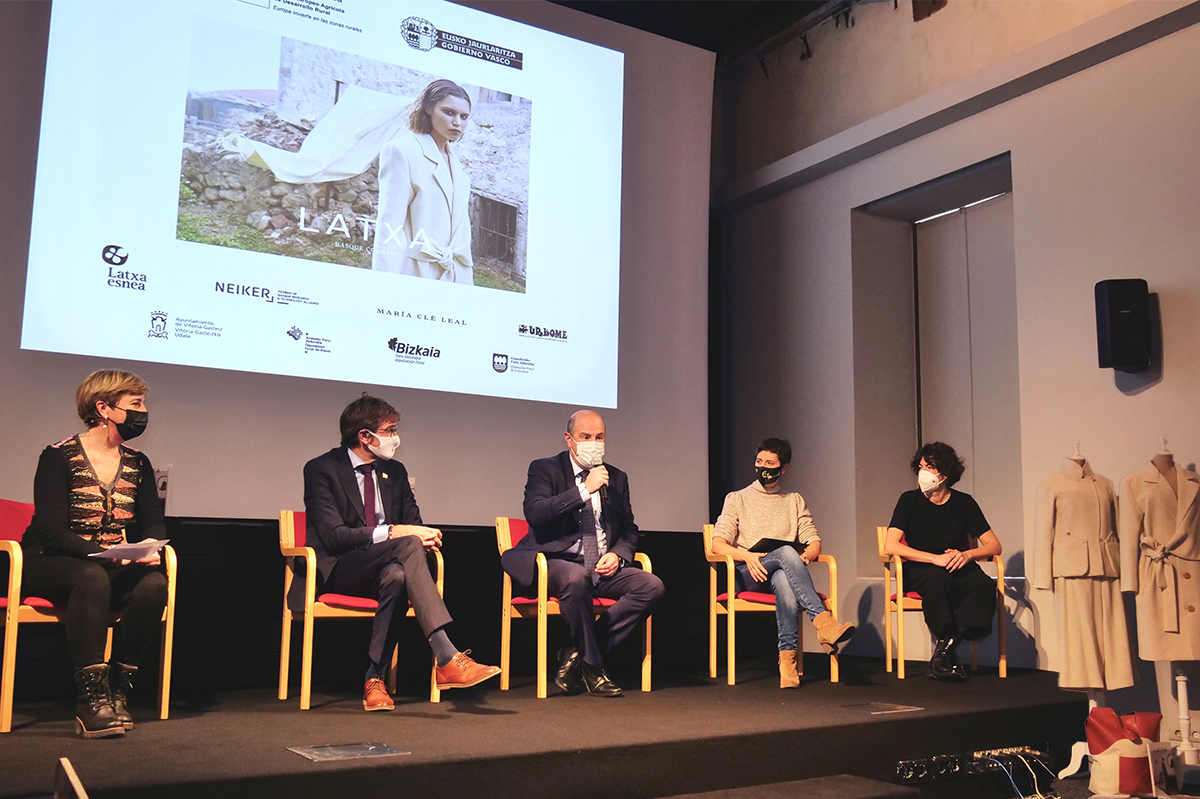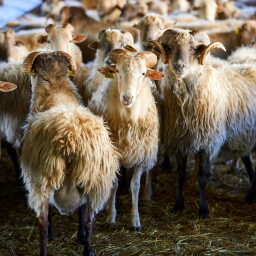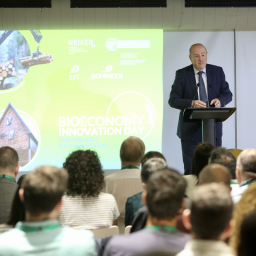NEW
Warm garments made with the fabric obtained after the textile valorisation of latxa wool
9 November 2021Warm garments made with the fabric obtained after the textile valorisation of latxa wool
- The Basque designer María Clè Leal presented today in Vitoria-Gasteiz a collection of warm garments made with the fabric obtained within the framework of the Latxari project for the textile valorisation of latxa wool.
- This initiative, in which the NEIKER technology centre, Latxa Esnea Koop and ADR Urkome also participate, aims to give a second life to a waste that is difficult for the primary sector to manage.
- The project is part of the Basque Government’s circular economy and bioeconomy plan and is co-financed by the Agricultural Fund for Rural Development (EAFRD).
It is estimated that the sheep sector shears around 2,000 tonnes of latxa sheep wool every year, which generates a problem of accumulation for livestock farms. What can be done with the 2 million kilos of latxa wool waste produced every year im teh Basque Country? To solve this textile accumulation problem, in 2020 the NEIKER technology centre, the fashion designer María Clè Leal and the rural development association of Urola Kosta, ADR Urkome, under the coordination of the Latxaesnea cooperative, joined forces in the Latxari project, a cooperation initiative that aims to develop new alternatives for the textile recovery of latxa wool for its commercialisation in different markets.
With a view to offering a sustainable and local alternative to this waste, the fashion designer María Clé Leal presented today, 9 November, in Vitoria-Gasteiz a collection of coats made with fabrics obtained from this wool thanks to the joint work of all the agents involved in Latxari.
During the presentation, a sample of the work carried out could be seen at the Montehermoso Cultural Centre in the capital of Alava: an outdoor fashion collection that revalues a natural fibre that is currently considered waste.
“The aim has not only been to achieve a unique and exclusive garment with more environmentally friendly properties, but also to ensure that the commercialisation of latxa sheep wool can add value to the livestock farms of these flocks”, explained Miriam Pinto, the researcher in charge of the project at NEIKER.
This has been possible thanks to the fact that “last May we managed to create a warp fabric easily adaptable to different fields and markets from the combination of latxa sheep’s wool in different proportions, recycled material and other natural fibres”, added the designer María Clè Leal.
The design of this textile collection made up of a series of warm garments with their corresponding accessories is a first milestone on the road to opening up a new business channel to solve the problem of accumulation and annual management of the latxa sheep’s wool. “This project is part of a broader line of work on this problem, as we are aware that there will still be tonnes of wool that will have to be disposed of through other projects”, explained Virginia Ortiz de Barrón, coordinator of Latxasnea.
In the words of Clè Leal, in charge of the design and making of the final product, “this proposal is intimately linked by concept and design to Basque culture and identity. We have achieved timeless and versatile designs, with a clean and sober cut, where the value of good traditional tailoring know-how is of paramount importance”.
Euskadi’s commitment to the revaluation of wool
On an institutional level, the event was attended by Bittor Oroz, Deputy Minister of Agriculture, Fisheries and Food Policy of the Basque Government; and Gorka Urtaran, Mayor of Vitoria-Gasteiz; as well as Miriam Pinto, researcher at NEIKER; Virginia Ortiz de Barrón, coordinator of the Latxa Esnea cooperative; and Yurre Peñagarikano, manager of ADR Urkome.
As the Basque Government’s Deputy Minister of Agriculture, Fisheries and Food Policy pointed out during his speech, “with this action we want to help sheep farms to solve the problems caused by the management of this waste. From now on, livestock farmers will have a new value-added use for sheared wool, demonstrating the Basque Country’s firm commitment to the revaluation of this material through sustainable and local initiatives, strengthening the Circular Economy and Bioeconomy strategy presented recently”.
“There is increasing public and business awareness in the fight against climate change and fortunately more and more initiatives are emerging that are committed to productive and creative processes that have the circular economy at the centre of their strategy”, emphasised Mayor Gorka Urtaran, who congratulated María Clè Leal and the entities involved. “Today we know about this interesting proposal, through fashion, and we do it in Vitoria-Gasteiz, a city committed to the transition from green city to green economy. Like the Vitoria-Gasteiz Green Deal, this initiative is based on the green economy, social cohesion and the protection of the natural environment”.
Thanks to the good results obtained, the agents involved in the initiative are now studying the possibility of collaborating with other Basque companies from different fields that share the same sustainable philosophy in order to give greater visibility to the fabric and the products designed and made from it, with the aim of creating a seal of quality that is closely linked to the use of this fibre.
The work carried out in Latxari (“Alternatives for the textile valorisation of latxa wool for its commercialisation in different markets”) is eligible for aid for the creation and operation of Operational Groups of the European Innovation Partnership (EIP) in the field of agricultural productivity and sustainability, 75% of which is financed by the Agricultural Fund for Rural Development (EAFRD) and the Basque Government. This initiative is part of the Basque Government’s bioeconomy plan.
This project has also been supported by the Vitoria-Gasteiz City Council and the Provincial Councils of Alava, Bizkaia and Gipuzkoa.






